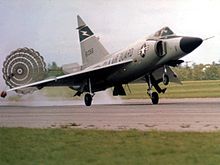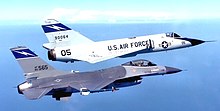159th Fighter Squadron
| 159th Fighter Squadron | |
|---|---|
 159th Fighter Squadron F-15s over Jacksonville Beach, FL. Aircraft are McDonnell Douglas F-15C-21-MC Eagles, AF Ser. No. 78-0487; 78-0527 and 78-0493 | |
| Active | 1 October 1942–Present |
| Country | |
| Allegiance | |
| Branch | |
| Type | Squadron |
| Role | Air Defense Fighter |
| Part of | Florida Air National Guard |
| Garrison/HQ | Jacksonville International Airport (Air National Guard Base), Florida |
| Nickname(s) | Boxin' Gators |
| Tail Code | Blue tail stripe with white trim, "Florida" in white letters on the outboard, 125th FW on the inboard, blue lightning bolt |
| Insignia | |
| 159th Fighter Squadron emblem |  |
The 159th Fighter Squadron (159 FS) is a unit of the Florida Air National Guard's 125th Fighter Wing (125 FW) located at Jacksonville Air National Guard Base at Jacksonville International Airport, Florida. The 159th is currently equipped with the F-15C and F-15D Eagle and is slated to transition to the F-35A Lightning II in 2024.
Overview
The squadron primarily flies the single seat
Mission
The mission of the 159 FS is to provide air defense for the southeastern United States, as directed by the
History
World War II
Established in late 1942 as a
The unit served primarily as an escort organization, covering the penetration, attack and withdrawal of USAAF
The squadron supported the airborne attack in the Netherlands in September 1944 and upgraded to the
Florida Air National Guard
The early post-war years

At the conclusion of

A facility for housing the units became available in temporary World War II buildings on the west side of the
Combat in Korea
In the fall of 1950, the United States' involvement in the
By 10 August 1951, upon arrival overseas, the 159th Fighter Squadron operated under the command of Major Dan Sharpe, USAF. The 116th Fighter Group was then assigned to the
After Korea


Upon its release from active duty, the unit returned on 9 July 1952 with their new commander to Imeson Municipal Airport in Jacksonville. The unit's F-84Es and all its ground equipment were turned over to the U.S. Air Force and left in Japan. On 10 July 1952, the 159th Fighter Squadron, Jet Propelled, was re-designated the 159th Fighter Bomber Squadron, dissolving the 159th Utility Flight and integrating it into the unit. Six months later, the 159th Fighter Bomber Squadron was re-equipped with F-51H Mustangs and re-designated the 159th Fighter Bomber Squadron Augmented (159 FBSA). From October to December 1954, the 159 FBSA was equipped with nine different types of aircraft such as the
In July 1955, while still equipped with F-80Cs, the unit was re-designated the 159th Fighter-Interceptor Squadron (159 FIS), with a mission change to Air Defense. By 1 July 1956, the parent unit reorganized into 125th Fighter-Interceptor Group (125 FIG) and both organizations were operationally gained by
Following the
The 1970s to the present


In 1974, the 125th Fighter-Interceptor Group converted from the F-102 Delta Dagger to the
In October 1979, in anticipation of the inactivation of Aerospace Defense Command, the USAF gained command responsibilities which shifted to
The 159th Fighter Interceptor Squadron flew the F-106 Delta Dart for 12 years but, by the end of 1986, the U.S. Air Force began to phase out the F-106, converting Regular Air Force units flying the Delta Dart to the
In January 1987, the unit converted to the F-16A, followed by a small number of additional twin-seat F-16Bs. On 1 April 1987, the 159 FIS became the first F-16 unit to sit alert in an Air Defense role as a fighter interceptor unit on a 24/7/365 basis. This conversion also marked the 11th fighter aircraft conversion for the unit. Following avionics upgrades tailored for the Air Defense mission, these aircraft would become known as the F-16ADF.
In June 1992, after the inactivation of Tactical Air Command, the 159 FIS was once again redesignated as the 159th Fighter Squadron (159 FS). The 125 FIG was concurrently redesignated as the 125th Fighter Group (125 FG) and both organizations operationally gained by the newly established Air Combat Command (ACC).
In 1995, the 159th Fighter Squadron converted from the F-16ADF to the A and B versions of the F-15 Eagle as its primary fighter aircraft. That same year, the parent unit for the 159 FS, the 125 FG, was redesignated the 125th Fighter Wing (125 FW), placing the unit on par organizationally with Regular US Air Force fighter units. Five years after the conversion to the F-15, Fighter Data Link (FDL) technology was incorporated into the F-15, allowing the pilots to link flight data with multiple users, providing real-time information on air and ground threats. The 159th continued to incorporate newer technology in its 1970s era F-15As and F-15Bs under the F-15 Multistage Improvement Program (F-15 MSIP), such as the upgrade to 220E model engines.
During the late 1990s, the 159 FS was also fully integrated into the USAF Air and Space Expeditionary Force (AEF) and routinely deployed aircraft and personnel to the
In 2006, the 159 FS replaced its previous F-15A/B Eagle (MSIP) aircraft with its current F-15C and F-15D variants.
In 2015, the 159 FS (temporarily redesignated the 159th Expeditionary Fighter Squadron) deployed as the first ever Air National Guard Theater Security Package to augment
Lineage

- Constituted as the 352d Fighter Squadron (Single Engine) on 29 September 1942
- Activated on 1 October 1942
- Inactivated on 18 October 1945
- Redesignated: 159th Fighter Squadron, Single Engine and allotted to Florida ANG, on 24 May 1946
- Extended federal recognition on 9 February 1947
- Redesignated: 159th Fighter Squadron, Jet on 1 August 1948
- Federalized and placed on active duty, 10 October 1950
- Redesignated: 159th Fighter-Bomber Squadron on 1 November 1950
- Released from active duty and returned to Florida state control, 10 July 1952
- Redesignated: 159th Fighter-Interceptor Squadron on 10 July 1952
- Redesignated: 159th Fighter Squadron on 15 March 1992
Assignments
- 353d Fighter Group, 1 October 1942 – 18 October 1945
- 54th Fighter Wing, 9 February 1947
- 116th Fighter Group, 10 October 1950
- 116th Fighter-Bomber Group, 11 November 1950
- 116th Fighter-Interceptor Group, 10 July 1952
- 116th Fighter-Bomber Wing, 1 December 1952
- 116th Fighter Group(Air Defense), 1 July 1955
- 125th Fighter Interceptor Group, 1 July 1956
- 125th Fighter Group, 15 March 1992
- 125th Operations Group, 1 August 1995 – present
Stations
|
|
Aircraft
|
|
Squadron Future
The 159th Fighter Squadron has been slated to transition from the F-15C/D to the F-35A Lightning II multirole fighter. Pilots in the squadron have already begun the transition to the new airframe. The transition will take place in 2024. The F-15C is projected to run out of service life in the mid-2020's across the Air Force and Air National Guard.
References
![]() This article incorporates public domain material from the Air Force Historical Research Agency
This article incorporates public domain material from the Air Force Historical Research Agency
- ^ "Florida Air National Guard - Units". Archived from the original on 3 April 2011. Retrieved 27 March 2011.
- ^ "First Air National Guard theater security package deploys to Europe". Archived from the original on 16 February 2016. Retrieved 11 February 2016.
- Maurer, Maurer (1983). Air Force Combat Units of World War II. Maxwell AFB, AL: Office of Air Force History. ISBN 0-89201-092-4
- Florida ANG 60th Anniversary History Document
- Rogers, B. (2006). United States Air Force Unit Designations Since 1978. ISBN 1-85780-197-0
- Cornett, Lloyd H. and Johnson, Mildred W., A Handbook of Aerospace Defense Organization 1946–1980, Office of History, Aerospace Defense Center, Peterson AFB, CO (1980). Archived 13 February 2016 at the Wayback Machine


